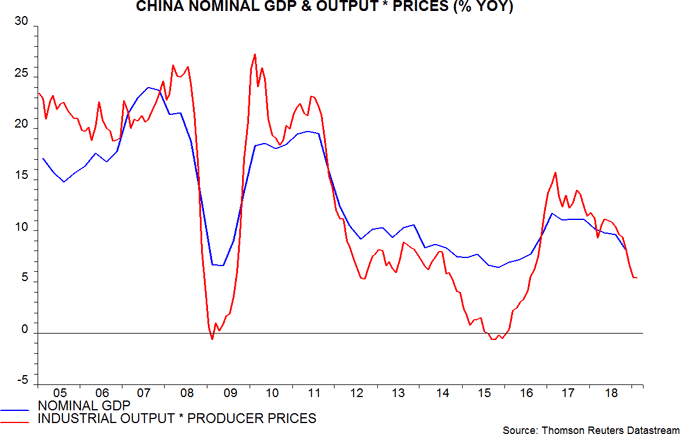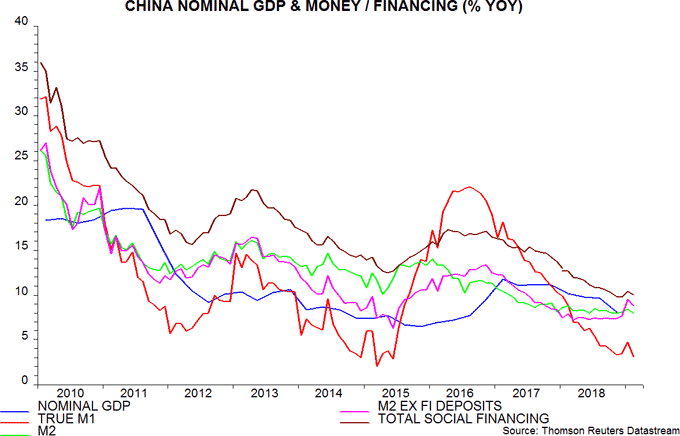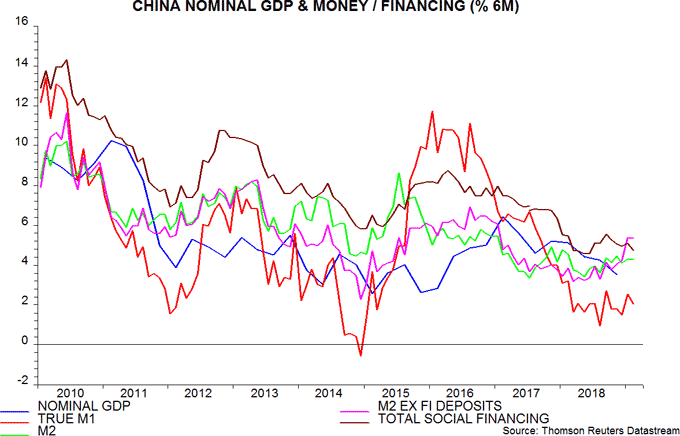Chinese money and credit trends remain weak, casting doubt on claims that policy stimulus is gaining traction and will lead to a significant recovery in economic momentum later in 2019.
Economic data for January / February signal a further decline in year-on-year nominal GDP growth in the first quarter– see first chart. Additional weakness had been expected given a continued softening of narrow money and credit trends through 2018.

A strong monthly flow of broad credit – “total social financing” (TSF) – in January was trumpeted by optimists as signalling a turning point. Such an interpretation was hazardous given the volatility of the monthly data and a likely positive New Year timing effect. The February number, unsurprisingly, slumped.
The optimists argue that the combined January / February flow was still 25% higher than a year before but this creates a misleading impression. Expressed as a percentage of the stock, the January / February increase was 2.5%, which – although up from 2.2% last year – was lower than January / February growth in each year from 2013 through 2017.
Year-on-year TSF growth fell back from 10.4% in January to 10.1% in February, barely higher than December’s 9.8% record low – second chart.

The forecasting approach here focuses on narrow money rather than credit but recent trends are equally discouraging. After a small rally in December / January, year-on-year growth of true M1 – which adds household demand deposits to the official M1 measure – declined to a new 44-month low in February.
Broad money trends are somewhat difficult to interpret. Year-on-year M2 growth fell back to its recent low of 8.0% in February. A contraction of bank deposits of non-bank financial institutions, however, has exerted a major drag on the aggregate in recent months, i.e. M2 growth excluding such deposits has picked up. The judgement here is that these trends reflect the clampdown on shadow banking and a consequent shift of business onto banks’ balance sheets. The rise in M2 growth of households and non-financial enterprises / government organisations may have been offset by a reduction (unrecorded) in holdings of shadow system liabilities, such as wealth management products. The shadow system contraction may also explain the fall in deposits of non-bank financial institutions. If this interpretation is correct, aggregate M2 may currently be the better measure to use for assessing economic prospects.
Shorter-term trends in the money / credit aggregates give a similarly downbeat message to year-on-year growth rates. Six-month growth of true M1 remains range-bound at a low level, while that of TSF has slipped back – third chart.

Six-month real growth rates have been boosted by a recent energy-driven fall in consumer price inflation but this is likely to unwind into mid-year.